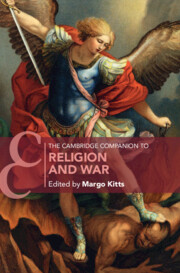Book contents
- The Cambridge Companion to Religion and War
- Cambridge Companions to Religion
- The Cambridge Companion to Religion and War
- Copyright page
- Contents
- Contributors
- Preface
- Introduction
- Part I Classical Foundations
- Part II Just War
- Part III Religious Nationalism
- 14 War in Religious Zionism
- 15 Christian Nationalism and Millennialism in the USA
- 16 The Elusive Dream of Pan-Islamism
- 17 Killing for the Hindu Nation
- 18 Nationalism, Violence and War in Myanmar’s Theravāda Buddhist Context
- Part IV Featured Conflicts
- Index
- Cambridge Companions to Religion (continued from page ii)
- References
18 - Nationalism, Violence and War in Myanmar’s Theravāda Buddhist Context
from Part III - Religious Nationalism
Published online by Cambridge University Press: 04 May 2023
- The Cambridge Companion to Religion and War
- Cambridge Companions to Religion
- The Cambridge Companion to Religion and War
- Copyright page
- Contents
- Contributors
- Preface
- Introduction
- Part I Classical Foundations
- Part II Just War
- Part III Religious Nationalism
- 14 War in Religious Zionism
- 15 Christian Nationalism and Millennialism in the USA
- 16 The Elusive Dream of Pan-Islamism
- 17 Killing for the Hindu Nation
- 18 Nationalism, Violence and War in Myanmar’s Theravāda Buddhist Context
- Part IV Featured Conflicts
- Index
- Cambridge Companions to Religion (continued from page ii)
- References
Summary
This chapter examines the ambivalence and tension generated when the putatively universal premodern category of sāsana (referring to the full range of material and ideational aspects of the Buddhist community) aligns uncomfortably with the more bounded modern category of the nation-state. Through its association with existing polities, sāsana has been effectively mobilized to encourage or defend violence against non-Buddhists and against coreligionists, sometimes producing the complicated phenomenon of “Buddhist nationalism.”
Keywords
- Type
- Chapter
- Information
- The Cambridge Companion to Religion and War , pp. 369 - 382Publisher: Cambridge University PressPrint publication year: 2023



